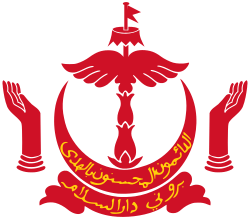Bruneian Empire
| Empire of Brunei | ||||||||||||||||||||||
| امبراطورية بروني | ||||||||||||||||||||||
| ||||||||||||||||||||||
|
| ||||||||||||||||||||||
 The extent of the Bruneian Empire in the 15th century | ||||||||||||||||||||||
| Capital | Kota Batu Kampong Ayer[1] Brunei Town | |||||||||||||||||||||
| Languages | Brunei Malay, Old Malay, Arabic and Bornean languages | |||||||||||||||||||||
| Religion | Sunni Islam | |||||||||||||||||||||
| Government | Monarchy | |||||||||||||||||||||
| Sultan (until last empire) | ||||||||||||||||||||||
| • | 1368–1402 | Sultan Muhammad Shah | ||||||||||||||||||||
| • | 1425–1432 | Sultan Sharif Ali of Mecca | ||||||||||||||||||||
| • | 1485–1524 | Sultan Bolkiah | ||||||||||||||||||||
| • | 1828–1852 | Sultan Omar Ali Saifuddin II | ||||||||||||||||||||
| • | 1885–1906[2] | Sultan Hashim Jalilul Alam Aqamaddin | ||||||||||||||||||||
| Historical era | Golden Age | |||||||||||||||||||||
| • | Sultanate established | 1368 | ||||||||||||||||||||
| • | Became protectorate of British | 1888 | ||||||||||||||||||||
| Currency | Barter, Cowrie and later Brunei pitis | |||||||||||||||||||||
| ||||||||||||||||||||||
| Today part of | | |||||||||||||||||||||
Part of a series on the |
||||||||||||||||||||||||||
|---|---|---|---|---|---|---|---|---|---|---|---|---|---|---|---|---|---|---|---|---|---|---|---|---|---|---|
| History of Brunei | ||||||||||||||||||||||||||
 | ||||||||||||||||||||||||||
| Pre-Sultanate | ||||||||||||||||||||||||||
|
||||||||||||||||||||||||||
|
||||||||||||||||||||||||||
| ||||||||||||||||||||||||||
Part of a series on the |
|---|
| History of the Philippines |
 |
|
Neolithic age
Events/Artifacts |
|
Indianized (Buddhist-Hindu Kingdoms)
Sinified Kingdoms Animist States Muslim States Events/Artifacts
|
|
Spanish era
|
| Timeline |
|
|
Part of a series on the |
||||||||||||||||||||||||||||||||||||||
|---|---|---|---|---|---|---|---|---|---|---|---|---|---|---|---|---|---|---|---|---|---|---|---|---|---|---|---|---|---|---|---|---|---|---|---|---|---|---|
| History of Indonesia | ||||||||||||||||||||||||||||||||||||||
   | ||||||||||||||||||||||||||||||||||||||
| Timeline | ||||||||||||||||||||||||||||||||||||||
|
||||||||||||||||||||||||||||||||||||||
|
Hindu and Buddhist kingdoms
|
||||||||||||||||||||||||||||||||||||||
|
Rise of Muslim states
|
||||||||||||||||||||||||||||||||||||||
|
Christian kingdom
|
||||||||||||||||||||||||||||||||||||||
|
European colonisation
|
||||||||||||||||||||||||||||||||||||||
|
Emergence of Indonesia
|
||||||||||||||||||||||||||||||||||||||
|
Independence
|
||||||||||||||||||||||||||||||||||||||
|
| ||||||||||||||||||||||||||||||||||||||
The Bruneian Empire or Empire of Brunei was a Malay Sultanate, centred in Brunei on the northern coast of Borneo island in Southeast Asia. The kingdom was founded in the early 7th century, started as a small seafaring trading kingdom ruled by a native pagan or Hindu king known by the Chinese as Po-Li or Po-Ni (渤泥). Bruneian kings converted to Islam in around the 15th century, after which it grew substantially since the fall of Malacca to the Portuguese,[3][4] extending throughout coastal areas of Borneo and the Philippines, before declining in the 17th century.[5]
History
Understanding the history of the Bruneian Empire is quite difficult since it is hardly mentioned in contemporary sources of its time, as well as there being a scarcity of evidence of its nature. No local or indigenous sources exist to provide evidence for any of this. As a result, Chinese texts have been relied on to construct a history of early Brunei.[6] Boni in Chinese sources most likely refers to Borneo as a whole, while Poli 婆利, probably located in Sumatra, is claimed by local authorities to refer to Brunei as well.[7]
Early history
The earliest diplomatic relations between Boni 渤泥 and China are recorded in the Taiping Huanyu Ji 太平環宇記 (978).[7]
In 1225, a Chinese official, Zhao Rugua, reported that Boni had 100 warships to protect its trade, and that there was a lot of wealth in the kingdom.[8]
In the 14th century, Brunei seems to be subjected to Java. The Javanese manuscript Nagarakretagama, written by Prapanca in 1365, mentioned Barune as the vassal state of Majapahit,[9] which had to make an annual tribute of 40 katis of camphor. In 1369, the Sulus attacked Po-ni, looting it of treasure and gold. A fleet from Majapahit succeeded in driving away the Sulus, but Po-ni was left weaker after the attack.[10] A Chinese report from 1371 described Po-ni as poor and totally controlled by Majapahit.[11]
Expansion
After the death of its emperor, Hayam Wuruk, Majapahit entered the state of decline and was unable to control its overseas possessions. This opened the opportunity for Bruneian kings to expand their influence. Chinese Ming emperor Yongle, after ascending to throne in 1403, immediately dispatched envoys to various countries inviting them to pay tribute to Chinese court. Brunei immediately involved in lucrative tributary system with China.
By the 15th century, the empire became a Muslim state, when the King of Brunei converted to Islam, brought by Muslim Indians and Arab merchants from other parts of Maritime Southeast Asia, who came to trade and spread Islam.[12][13] It controlled most of northern Borneo, and it became an important hub for the East and Western world trading system.[14]
The Bruneian empire, just like previous regional empires of Srivijaya, Majapahit, and Malacca, can be considered as a thalassocratic empire that was based upon maritime power, which means its influence was only confined to coastal towns, ports and river estuarines, and seldom penetrated deep into the interior of the island. The Bruneian kings seems to cultivated alliance with regional seafaring peoples of Orang Laut and Bajau that formed their naval armada. The Dayaks, native tribes of interior Borneo however, were not under their control, as its influence seldom penetrated deep into the jungles.
The earliest recorded documentation by the West about Brunei was by an Italian known as Ludovico di Varthema. Ludovico was at the time on a route to the Maluku Islands when he landed in Borneo and met with the people of Brunei. The record of his documentation dates back to 1550.[13][15][16]
"We arrived at the island of Bornei (Brunei or Borneo), which is distant from the Maluch about two hundred miles, and we found that it was somewhat larger than the aforesaid and much lower. The people are pagans and are men of goodwill. Their colour is whiter than that of the other sort....in this island justice is well administered..."[17]
During the rule of Bolkiah, the fifth Sultan, the empire controlled over coastal areas of northwest Borneo (present-day Brunei, Sarawak and Sabah) and reached Seludong (present-day Manila), Sulu Archipelago including parts of the island of Mindanao.[12][18][19][20][21][22][23][24] In the 16th century, the Brunei empire's influence also extended as far as Kapuas River delta in West Kalimantan. The Malay Sultanate of Sambas in West Kalimantan and Sultanate of Sulu in Southern Philippines in particular has developed dynastic relations with the royal house of Brunei. Other Malay sultans of Pontianak, Samarinda as far as Banjarmasin, treated the Sultan of Brunei as their leader. The true nature of Brunei's relations to other Malay Sultanates of coastal Borneo and Sulu archipelago is still a subject of study. Whether it was a vassalised state, an alliance or just a ceremonial relationship. Since there was other regional polities also exercised their influence upon these sultanates. Sultanate of Banjar (present day Banjarmasin) for example, was also under the influence of Demak in Java.
Decline
By the end of 17th century, Brunei subsequently entered a period of decline brought on by internal strife over royal succession, colonial expansion of European powers, and piracy.[5] The empire lost much of its territory due to the arrival of the western powers such as Spanish in the Philippines, Dutch in southern Borneo and the British in Labuan, Sarawak and North Borneo. Sultan Hashim Jalilul Alam Aqamaddin later appealed to the British to stop further encroachment in 1888.[25] In the same year British signed a "Treaty of Protection" and made Brunei a British protectorate,[5] until 1984 when it gained independence.[23][26]
References
- ↑ B. A. Hussainmiya (2010). "The Malay Identity in Brunei Darussalam and Sri Lanka" (PDF). Universiti Brunei Darussalam. pp. 67 and 68/3 and 4. Retrieved 29 October 2014.
- ↑ Rozan Yunos (3 August 2008). "The Sultan who thwarted Rajah Brooke". The Brunei Times. Archived from the original on 30 September 2015. Retrieved 30 September 2015.
- ↑ P. M. Holt; Ann K. S. Lambton; Bernard Lewis (21 April 1977). The Cambridge History of Islam: Volume 2A, The Indian Sub-Continent, South-East Asia, Africa and the Muslim West. Cambridge University Press. pp. 129–. ISBN 978-0-521-29137-8.
- ↑ Barbara Watson Andaya; Leonard Y. Andaya (19 February 2015). A History of Early Modern Southeast Asia, 1400-1830. Cambridge University Press. pp. 159–. ISBN 978-0-521-88992-6.
- 1 2 3 "Brunei, Background". The World Factbook CIA. Retrieved 27 October 2014.
- ↑ Jamil Al-Sufri, Tarsilah Brunei: The Early History of Brunei up to 1432 AD (Bandar Seri Begawan: Brunei History Centre, 2000)
- 1 2 Johannes L. Kurz. "Boni in Chinese Sources: Translations of Relevant Texts from the Song to the Qing Dynasties" (PDF). Universiti Brunei Darussalam. National University of Singapore. p. 1. Archived from the original (PDF) on 22 May 2014. Retrieved 1 June 2014.
- ↑ History for Brunei 2009, p. 43
- ↑ "Naskah Nagarakretagama" (in Indonesian). Perpustakaan Nasional Republik Indonesia. Retrieved 13 October 2014.
- ↑ History for Brunei 2009, p. 44
- ↑ History for Brunei 2009, p. 45
- 1 2 Graham Saunders (5 November 2013). A History of Brunei. Taylor & Francis. pp. 23 & 60. ISBN 978-1-136-87401-7.
- 1 2 Awang Abdul Aziz bin Awang Juned (Pehin Tuan Imam Dato Paduka Seri Setia Ustaz Haji.) (1992). Islam di Brunei: zaman pemerintahan Kebawah Duli Yang Maha Mulia Paduka Seri Baginda Sultan Haji Hassanal Bolkiah Mu'izzuddin Waddaulah, Sultan dan Yang Di-Pertuan Negara Brunei Darussalam (in Malay). Jabatan Pusat Sejarah Brunei Darussalam.
- ↑ Oxford Business Group. The Report: Sabah 2011. Oxford Business Group. pp. 179–. ISBN 978-1-907065-36-1.
- ↑ The Brunei Museum Journal. The Museum. 1986.
- ↑ Awang Mohd. Zain Jamil Al-Sufri (1990). Tarsilah Brunei: sejarah awal dan perkembangan Islam (in Malay). Jabatan Pusat Sejarah Kementerian Kebudayaan, Belia, dan Sukan.
- ↑ Bilcher Bala (2005). Thalassocracy: a history of the medieval Sultanate of Brunei Darussalam. School of Social Sciences, Universiti Malaysia Sabah. ISBN 978-983-2643-74-6.
- ↑ Frans Welman (1 August 2013). Borneo Trilogy Brunei: Vol 1. Booksmango. pp. 8–. ISBN 978-616-222-235-1.
- ↑ David Lea; Colette Milward (2001). A Political Chronology of South-East Asia and Oceania. Psychology Press. pp. 16–. ISBN 978-1-85743-117-9.
- ↑ Patricia Herbert; Anthony Crothers Milner (1989). South-East Asia: Languages and Literatures : a Select Guide. University of Hawaii Press. pp. 99–. ISBN 978-0-8248-1267-6.
- ↑ Nigel Hicks (2007). The Philippines. New Holland Publishers. pp. 34–. ISBN 978-1-84537-663-5.
- ↑ Peter Church (3 February 2012). A Short History of South-East Asia. John Wiley & Sons. pp. 16–. ISBN 978-1-118-35044-7.
- 1 2 Harun Abdul Majid (15 August 2007). Rebellion in Brunei: The 1962 Revolt, Imperialism, Confrontation and Oil. I.B.Tauris. pp. 2 & 4. ISBN 978-1-84511-423-7.
- ↑ Eur (2002). The Far East and Australasia 2003. Psychology Press. pp. 203–. ISBN 978-1-85743-133-9.
- ↑ "Brunei Darussalam". http://www.worldatlas.com. External link in
|journal=(help) - ↑ Jatswan S. Sidhu (22 December 2009). Historical Dictionary of Brunei Darussalam. Scarecrow Press. pp. 92–. ISBN 978-0-8108-7078-9.
- http://www.quezon.ph/wp-content/uploads/2013/03/North-Borneo-2-300x212.jpg
- http://www.zum.de/whkmla/histatlas/seasia/brunei1846.gif
- http://www.zum.de/whkmla/histatlas/seasia/brunei1400.gif



